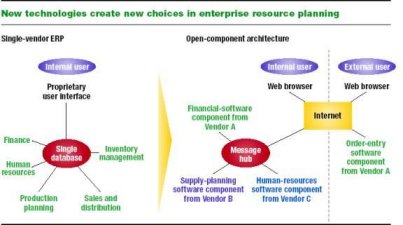|
Previous
Part - VI

Fig 3. A simple ERP system
For many businesses, installing ERP is traumatic. Following long, painful, and expensive implementations, some companies have difficulty identifying any measurable benefits. Yet companies shouldn't bemoan the cost of their investment: the hard-won skills and capabilities they acquire during the ERP installation process will permit them to improve their ERP applications incrementally, and these improvements collectively add considerable value.
Electronic procurement
On the buy side, attaching an e-procurement module to an ERP system can restrict purchases to preferred suppliers and cut out maverick spending by employees who have too little time to go through required procedures. Say an accountant needs a new computer. An e-procurement module allows that person to choose "computer supplies" from the procurement folder appearing on everyone's desktop and to select the desired model from the company's preferred supplier. The clincher is that the ERP system also receives and pays the invoice electronically, cutting out liaison with the accounts organization.
Continuous-relationship marketing
Electronic orders yield far more information about customers than over-the-counter sales do-not only who those customers are, but also what else they looked at and even, if one cares to track this, how much time they spent on each screen. An add-on application can combine customer data obtained from e-commerce with information in the existing ERP system, helping one cater to individual tastes and create lifelong relationships with customers.
Next
* Contributed by -
Siddharth Mohan Patnaik, B.Tech. (Electronics),
Ravulpathi Janaki, B.Tech. (Mechanical),
II Year, IIM Lucknow.
|